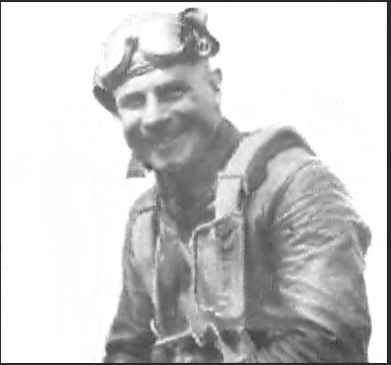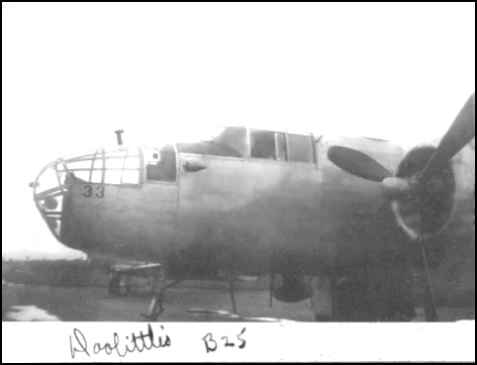
 |
|
FOR ATTACK ON TOKYO By Susan Meeker, Staff Reporter Colusa County Sun Herald Supplement to Tri-County Newspapers October 2003 It had been coffee shop talk throughout the war and was still being talked about a decade later. In fact, it was still talked about 20 years, 40 years, and even now, 60 years later. Sadly, there is no marker at the Willows Airport to mark the spot where Doolittle practiced for one of the war's most famous events on a small stretch of runway sectioned off to replicate the flight deck of the U.S.S. Hornet. There are only a few old newspaper clippings, and a notation in a historical society publication that commemorates the event that led up to America lashing back at Japan for the deadly attack on Pearl Harbor that killed over 2,000 Americans. While the country was still in a state of shock only three months later, Lt. Col. James Harold Doolittle led an unforgettable air raid on Tokyo on April 18, 1942. Doolittle, a close friend of Willows aviator Floyd Nolta, chose the Glenn County Airport as the location for the final rehearsals of the famous B-25 raid. In twin engine bombers, he and other "raiders" practiced takeoffs and landings over and over on an area of the runway marked off to replicate the U.S.S. Hornet's flight deck. It was going to be the first ever aircraft carrier based attack. It was going to be in and out. It was going to over in a matter of seconds. The Willows mission was so Top Secret, the Army Air Corps banned all aviation activity at the airport during the practice session. Then, in broad daylight on April 18, 1942, Doolittle led the 16 Army B-25 bombers through Japanese defenses to strike Tokyo and other cities. America was still in mourning that day. The Japanese, on the other hand, were basking in a sense of euphoria. Their armed forces were scoring one victory after another in the Pacific. Despite their country being at war, they had no reason to feel insecure. Not since Kubla Khan in the 13th century had their homeland been attacked. Not until Jimmy Doolittle, that is. The dash and daring of the raid shocked the Orient, it revived shattered American spirits, and set a new course for W.W.II in the Pacific. |
 |
|
Caption courtesy of George Nolta |
|
Lt. Col. Doolittle's B-25 bomber was the first to break through Japanese air defenses and the first to
drop its bomb load, destroying a large factory. He then flew west to reach the coast of China after dark. Out of fuel and unable to find an airfield in the fog, he ordered his crew to bail out. He then followed them into the night, his bomber crashing into the side of a nearby mountain. The locals escorted the crew to Chuchow from where they eventually reached home. Eighty men in five-man crews piloted 16 B-25 bombers that attacked Japan that day. None of the planes were shot down, but all were lost. The crews of 11 bombers bailed out over China. One crash landed upside down in a rice paddy. Three bombers ditched in the waters off the China coast. One landed in the Soviet Union where it was confiscated. Of the 80 men who flew with Doolittle that day, three were killed exiting their aircraft. Eight were captured by the Japanese, three of which were executed by their captors six months later. One POW died of torture and malnutrition six months after capture, but four POWs managed to survive nearly two years in captivity and were released at end of W.W. II. Following the famous Tokyo raid, most of the raiders went on to fly other combat missions. Before the war ended, 10 raiders were killed in action in Europe, North Africa, and Indochina, and four were shot down and interred as German prisoners of war. Only 18 of Doolittle's famous raiders are known to still be alive today. |
 |
The mission was later brought to the big screen in the movie "Thirty Seconds Over Tokyo." Doolittle's long-time friend, Willows Flying Service founder, Floyd Nolta, also a famous aviation pioneer, flew the lead aircraft in the movie. During the filming, Nolta flew a B-25 nearly identical to Doolittle's plane, under the San Francisco Bay Bridge (*) in an attempt to replicate events. The mission was more recently chronicled again in the movie "Pearl Harbor". * Other sources indicate that Doolittle flew his B-25 under the Golden Gate Bridge - not the Bay Bridge. |
On July 1, 1920 Doolittle got his regular commission and promotion to First Lieutenant. He then took the Air Service Mechanical School and Aeronautical Engineering courses at Kelly Field and McCook Field, Ohio, respectively. In September 1922 he made the first of many pioneering flights, which earned him most of the major air trophies and international fame. He flew a DH-4, equipped with crude navigational instruments, in the first cross-country flight, from Pablo Beach, Florida, to San Diego, California, in 21 hours and 19 minutes. He made only one refueling stop at Kelly Field. The military gave him the Distinguished Flying Cross for this historic feat. In the same year he received his Bachelor of Arts degree from the University of California. In July 1923, he entered Massachusetts Institute of Technology for special engineering courses and graduated the following year with a Master of Science degree, getting Doctor of Science degree in Aeronautics a year later, and being one of the first men in the country to earn this degree. In March, 1924, he served at McCook Field, conducting aircraft acceleration tests. In June, 1925, Doolittle went to the Naval Air Station in Washington, D.C., for special training in flying high-speed seaplanes. During this special period, he served with the Naval Test Board at Mitchel, N.Y., and was a familiar figure in airspeed record attempts in the New York area. He won the Schneider Cup Race – the World Series of seaplane racing – in 1925, with an average speed of 232 miles per hour in a Curtiss Navy racer, equipped with pontoons. This was the fastest a seaplane had ever flown, and Doolittle next year received the Mackay Trophy for this feat. In April 1926, he got a leave of absence to go to South America on airplane demonstration flights. In Chile, he broke both ankles, but put his Curtiss P-1 through stirring aerial maneuvers with his ankles in casts. He returned to the United States and was in Walter Reed Hospital for these injuries until April 1927, when he was assigned to McCook Field for experimental work and additional duty as instructor with Organized Reserves of the Fifth Corps Area's 385th Bomb Squadron. Returning to Mitchell Field in September 1928, he assisted in the development of fog flying equipment. He helped develop the now almost universally used artificial horizontal and directional gyroscopes and made the first flight completely by instruments. He attracted wide newspaper attention with this feat of "blind" flying and later received the Harmon Trophy for conducting the experiments. In January 1930, he was adviser for the Army on the building of the Floyd Bennett Airport in New York City. Doolittle resigned his regular commission Feb. 15, 1930, and was commissioned a major in the Specialist Reserve Corps a month later, being named manager of the Aviation Department of the Shell Oil Company, in which capacity he conducted numerous aviation tests. He also went on active duty with the Army frequently to conduct tests, and in 1932 set the world's high speed record for land planes. He won the Bendix Trophy Race from Burbank to Cleveland in a Laird Biplane, and took the Thompson Trophy Race at Cleveland in a Gee Bee racer with a speed averaging 252 miles per hour. In April 1934, Doolittle became a member of the Army Board to study Air Corp organization and a year later was transferred to the Air Corps Reserve. In 1940, he became president of the Institute of Aeronautical Science. He went back on active duty July 1, 1940, as a major and assistant district supervisor of the Central Air Corps Procurement District at Indianapolis, Indiana, and Detroit, Michigan, where he worked with large auto manufacturers on the conversion of their plants for production of planes. The following August, he went to England as a member of a special mission and brought back information about other countries' air forces and military buildups. He returned to active duty in the military at the onset of W.W.II. after leading the first carrier-based attack on Tokyo that fateful day in April, Doolittle was awarded the Medal of Honor, and was promoted to Brigadier General. His citation, presented personally by President Franklin d. Roosevelt, reads, in part: "With the apparent certainty of being forced to land in enemy territory or perish at sea, Colonel Doolittle personally led a squadron of Army bombers, manned by volunteer crews, in a highly destructive rain on the Japanese mainland." In addition to the nation's top award, Doolittle also received two Distinguished Service Medals, the Silver Star, three Distinguished Flying Crosses, Bronze Star, four Air Medals, and decorations from Great Britain, France, Belgium, Poland, China and Ecuador. In July 1942, as a Brigadier General (he had been advanced two grades the day after the Tokyo attack) Doolittle was assigned to the 8th Air Force and in September became commanding general of the 12th Air Force in North Africa. He was promoted to Major General in November and in March 1943 became Commanding General of the North African Strategic Air Forces. He took command of the 15th Air Force in the Mediterranean Theater in November and from January 1944 to September 1945 he commanded the 8th Air Force in Europe and the Pacific, until war's end, as a Lieutenant General, the promotion date being March 13, 1944. On May 10, 1946, he reverted to inactive reserve status and returned to Shell Oil as a Vice-president and later a director. In March 1951 he was appointed a special assistant to the Air Force chief of staff, serving as a civilian in scientific matters which led to Air Force ballistic missile and space programs. He retired from Air Force duty Feb. 28, 1959 but continued to serve his country as chairman of the board of Space Technology Laboratories. He also was the first president of the Air Force Association, in 1947, assisting its organization. Jimmie Doolittle lived well into his nineties, and died in California on September 27, 1993. He is buried in Arlington National Cemetery with his high school sweetheart and wife, Josephine Daniels Doolittle, who preceded him in death only five years earlier. |


|